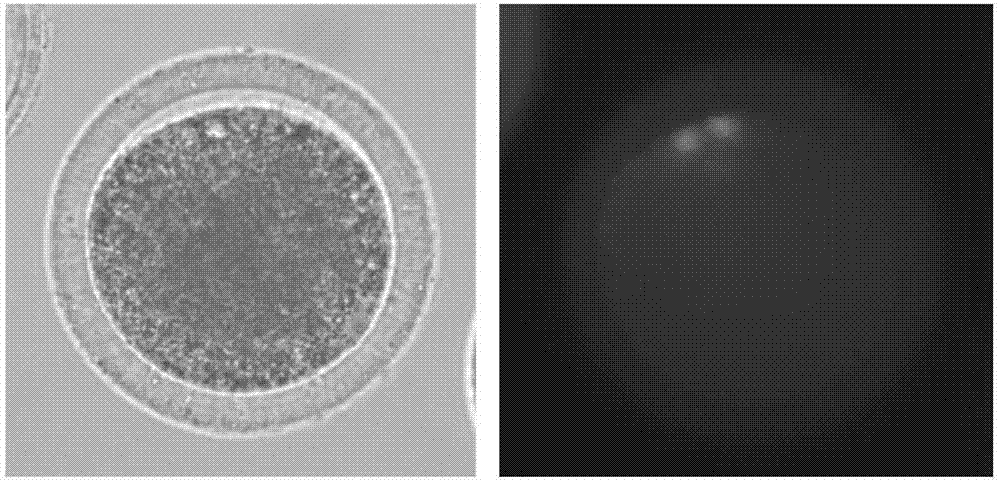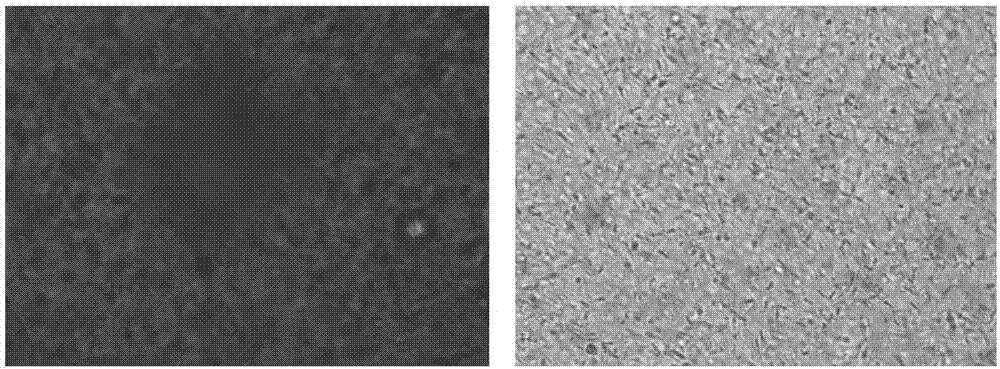Preparation method of heterogeneous in-vitro fertilization embryos of cows and cattle
An in vitro fertilization and cattle technology, which is applied in the field of cattle reproduction, can solve the problems of low culling rate of dairy cows, affecting in vitro fertilization, and high cost of feeding dairy cows, and achieve the effects of improving utilization rate, ensuring quality and in vitro maturation efficiency, and improving in vitro fertilization efficiency.
- Summary
- Abstract
- Description
- Claims
- Application Information
AI Technical Summary
Problems solved by technology
Method used
Image
Examples
Embodiment 1
[0026] [Example 1] Preparation method of Simontal cattle and yellow cattle heterogeneous in vitro fertilization embryos
[0027] (1) Put the cattle ovaries collected in the slaughterhouse into sterilized saline at 25°C with double antibodies and keep them at a constant temperature for 7 hours, then bring them back to the laboratory, wash them with sterile saline at 30°C and 35°C in sequence, and wash them twice respectively. Put it in a water bath at 39°C for standby, and obtain cumulus-oocyte complexes (COCs) by aspiration with a 10 ml disposable syringe;
[0028] (2) The picked cumulus-oocyte complexes (COCs) were washed 3 times with DPBS buffer containing 5% fetal bovine serum (FBS) preheated in a 39°C water bath 2 hours in advance, and then washed with advance 2h in vitro maturation medium preheated in a 39°C incubator, washed 3 times and placed in CO 2 Carry out in vitro maturation culture in an incubator, using five-well plate culture, culture concentration: 100-150 pie...
Embodiment 2
[0036] [Example 2] Hoechst 33342 staining identification
[0037] (1) Take part of the oocytes fertilized in step (6) of Example 1 and wash 3 times with DPBS;
[0038] (2) 2% hyaluronidase digestion to remove cumulus cells;
[0039] (3) Hoechst 33342 dark staining for 5-7min;
[0040] (4) Observation under the fluorescence of an inverted microscope as figure 1 As shown, the left picture is the oocyte after fertilization, and the right picture shows two luminous dots under the fluorescent field of view, which are the male pronucleus and the female pronucleus stained by Hoechst 33342, which shows that the heterogeneous sperm in vitro fertilization method is feasible .
Embodiment 3
[0041] [Example 3] hatching of blastocysts
[0042] (1) Bring the collected cattle ovaries back to the laboratory in normal saline (containing double antibody) within 3 hours, and obtain cumulus-oocyte complexes (COCs) by suction;
[0043] (2) Wash the cumulus-oocyte complexes (COCs) and culture them for 22-24 hours;
[0044] (3) Simontal cattle semen is treated with BO liquid float method;
[0045] (4) the mature oocytes in step (2) are digested to remove cumulus cells;
[0046] (5) the sperm in the step (3) is moved into the fertilized fluid, and the fertilized fluid contains the oocyte in the step (4);
[0047] (6) After 6-8 hours of fertilization, culture after washing, and change the medium in half for 24 hours;
[0048] (7) After 7 days of culture, blastocysts were observed, and half of the medium was changed for 24 hours. The results were as follows: figure 2 As shown, the left picture is a blastocyst, and the right picture shows that the zona pellucida will ruptur...
PUM
 Login to View More
Login to View More Abstract
Description
Claims
Application Information
 Login to View More
Login to View More - R&D
- Intellectual Property
- Life Sciences
- Materials
- Tech Scout
- Unparalleled Data Quality
- Higher Quality Content
- 60% Fewer Hallucinations
Browse by: Latest US Patents, China's latest patents, Technical Efficacy Thesaurus, Application Domain, Technology Topic, Popular Technical Reports.
© 2025 PatSnap. All rights reserved.Legal|Privacy policy|Modern Slavery Act Transparency Statement|Sitemap|About US| Contact US: help@patsnap.com



